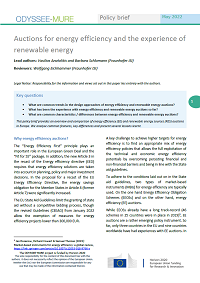Summary
Key questions
- What are common trends in the design approaches of energy efficiency and renewable energy auctions?
- What has been the experience with energy efficiency and renewable energy auctions so far?
- What are common characteristics / differences between energy efficiency and renewable energy auctions?
This policy brief provides an overview and comparison of energy efficiency (EE) and renewable energy sources (RES) auctions in Europe. We analyse common features, key differences and present several lessons learnt.
Lead authors: Vasilios Anatolitis and Barbara Schlomann (Fraunhofer ISI)
Reviewers: Wolfgang Eichhammer (Fraunhofer ISI)
Why energy efficiency auctions?
The “Energy Efficiency First” principle plays an important role in the European Green Deal and the “Fit for 55” package. In addition, the new Article 3 in the recast of the Energy efficiency directive (EED) requires that energy efficiency solutions are taken into account in planning, policy and major investment decisions. In the proposal for a recast of the EU Energy Efficiency Directive, the energy savings obligation for the Member States in Article 8 (former Article 7) were significantly increased.
The EU State Aid Guidelines limit the granting of state aid without a competitive bidding process, though the revised Guidelines (CEEAG) from January 2022 allow the exemption of measures for energy efficiency projects lower than 300,000 EUR.
A key challenge to achieve higher targets for energy efficiency is to find an appropriate mix of energy efficiency policies that allows the full exploitation of the technical and economic energy efficiency potentials by overcoming persisting financial and non-financial barriers and being in line with the State aid guidelines.
To adhere to the conditions laid out on in the State aid guidelines, two types of market-based instruments (MBIs) for energy efficiency are typically used. On the one hand Energy Efficiency Obligation Schemes (EEOSs) and on the other hand, energy efficiency (EE) auctions.
While EEOSs already have a long track-record (46 schemes in 25 countries were in place in 2019)1, EE auctions are a rather emerging policy instrument. So far, only three countries in the EU and nine countries worldwide have had experiences with EE auctions. In contrast, by 2020, 19 EU member states and more than 116 countries worldwide2 have had experiences with auctions for the support of renewable energy sources (RES). Therefore, this policy brief aims to provide a first overview of EE auctions in Europe and to identify lessons learnt from the experience with RES auctions.
What are energy efficiency auctions?
Energy efficiency auctions are, together with the EEOSs, part of the market-based instruments. In contrast to EEOSs, auctions do not oblige market actors, but rather encourage them to develop energy-saving projects and programmes and offer them in competition for funding budgets at the most favou¬ra¬ble cost-benefit ratios possible.
In an EE auction, the auctioneer, usually the govern-ment or a governmental agency, announce a certain volume of energy savings or budget that is auc-tioned. Interested bidders participate in the auction by submitting a bid that usually reflects a certain project and includes a certain amount of support needed to realise this project. The first auction-specific design element is the amount of support and related to that, the auctioned product itself. This can be usually defined in terms of energy or electricity savings or in monetary terms, i.e. a certain budget for support. Further¬more, the auction can be open to all technologies and projects that can contribute to achieve a certain objective, or can be segmented based on the technology or type of bidders. The auction procedure can either be static, i.e. bidders submit one bid which is final, or dynamic, i.e. bidders submit several bids over the course of time. Furthermore, the selection can be based on price only or incorporate additional criteria, such as innovation or local impact. The ceiling price defines the maximum bid that is allowed to be submitted. And lastly, penalties can be foreseen to safeguard the actual realisation of the awarded projects.
An overview of the actual auction design in selected EU countries can be found in Table 1.
What were the experiences with energy efficiency auctions?
Policy instruments, as e.g. EE or RES auctions, are typically assessed based on two objectives: effec-tive¬ness and (static) efficiency. In economic theory, static efficiency usually refers to awarding projects with the lowest cost. In RES auctions, this means levelised cost of electricity (LCOE), while in energy efficiency, this means the actual cost of conducting the energy effi¬cien¬cy action3. In practice, the definition of support cost efficiency is much more common, which means minimising the support expenditures to achieve a certain target.
Effectiveness means in general the ability to achieve a certain target with a specific policy instrument. RES auction literature distinguishes further between "a priori effectiveness" and "ex post effectiveness". The first refers to contracting the desired auctioned volume, i.e. not having undersubscribed auctions. The latter refers to achieving a high realisation rate, i.e. that all awarded projects are built.
Looking at EE auctions, it seems that by introducing auctions, policymakers were in general able to reduce the support expenditures needed for energy savings, thus achieving support cost efficiency.
Nevertheless, in many instances, we observe low levels of competition in EE auctions. On the one hand, this can harm the support cost efficiency, since bidders could potentially submit unreasonably high bid prices without the risk of not being awarded. Nevertheless, undersubscription seems to be not as grave as in RES auctions, as bidders in EE auctions need to submit their (verifiable) true costs. In RES auctions, bidders are free to submit any price (up to the ceiling price). Thus, the low levels of competition have a much more pronounced negative effect on the a priori effectiveness, as policymakers are not able to contract their desired auctioned volumes.
Reasons behind these low levels of competition are manifold. Parallel non-auction based funding opportunities (“outside options”) can distract bidders from participating in the auctions. High transaction costs for participating and the risk of not being awarded can further strengthen this effect.
Regarding the ex-post effectiveness, the actual implementation of the awarded EE actions is questionable, but robust information on the realisation of awarded projects is not (yet) available.
Besides effectiveness and efficiency, other secondary objectives of support mechanism exist, such as green growth or actor diversity. Regarding the latter, it seems that EE auctions have a relatively high share of large enterprises and rather a low number of SMEs.
Auctions for energy efficiency and renewable energy – What can they learn from each other?
As already stated, EE auctions seem to have been successful in driving down support expenditures, but failed to achieve sufficient numbers of bidders. Nevertheless, given the long experience of conducting RES auctions, a comparison of the two auction schemes seems promising.
There are several common characteristics between the EE and RES auctions:
In both schemes, outside options and parallel funding opportunities need to be taken into account. These might decrease the incentive to participate in the actual auction procedures and thus can lead to lower competition. Furthermore, whenever a new support scheme is introduced, a “rush effect” to the old system can be observed, i.e. that potential bidders rather opt for the old and better-known scheme.
In terms of design elements, multi-item auctions are commonly used in both types of auctions. In addition, the segmentation of auctions (typically based on the size, technology, and/or the actor). Furthermore, pay-as-bid as seems to be the preferred pricing rule in both schemes. In contrast, multi-criteria auctions are rarely used, which might indicate that policymakers rather focus on support cost efficiency and not on other, secondary objectives.
Nevertheless, several key differences exist between EE and RES auctions:
EE auctions usually follow a predetermined schedule, RES auctions in some instances not. A long-term auction schedule typically fosters investor confidence and can thus decrease cost of capital and in addition, avoids "stop-and-go" cycles in the respective value chain/industry.
The auctioned product in RES auctions is usually capacity or electricity, while EE auctions usually allocate a pre-determined budget for support. Auctioning a certain budget provides governments security over the (future) support expenditures, but leads to uncertainty regarding the contracted energy savings.
A further difference between the two auction schemes is the “payback period”, which is a prominent design element in EE auctions to ensure additionality of the support. While other prequalification requirements can be found in RES auctions, additionality is not a big concern, as policymakers assume that projects not needing the support payments will not participate in the auctions from the beginning.
To ensure a sufficient level of competition, EE auctions have often an automatic volume adjustment in place. This mechanism artificially creates competi¬tion by decreasing the auctioned volume based on the received number of bids. The number of RES auctions using this design element is still rather low, but with an increasing tendency in the recent years.
Furthermore, ceiling prices are usually implemented to safeguard governments from excessive bid prices in case an auction is undersubscribed. While this has become a common design element in RES auctions, EE auctions still rarely apply it. And if it is the case, it is rather defined as an absolute, maximum support amount, and not in relative terms, i.e. in support per saving unit.
RES auctions usually have (additional) non-performance penalties in place that aim to ensure a high realisation rate of awarded projects. This design element is largely absent in EE auctions, which can lead to a high number of non-realised projects.
The actual support for RES generators is usually paid out based on the electricity generated by the power plants. In contrast, support for EE actions is typically paid out as a lump sum and more specifically, as a percentage of a project's CAPEX.
Conclusions and policy recommendations
Since EE auctions are a relatively new phenomenon, there is still room for learning and improvement in the design.
To increase competition and the number of bidders in EE auctions, policymakers should consider the follow¬ing recommendations. Policymakers should take into account parallel funding opportunities ("outside options"), as they divert interest from investors away from auctions. Furthermore, to increase the number of eligible projects, policymakers should consider decreasing the minimum payback period. In addition, we propose to further research the effects of the volume adjustment mechanism, as it is suspected to have a counteractive effect on the competition in the mid- to long-term.
Another challenge EE auctions potentially face is the objective of effectiveness, i.e. achieving a high realisation rate of projects, which is a concern in RES auctions, as well. Effectiveness can be achieved by introducing non-performance penalties and financial prequalification criteria, which are currently not applied in EE auctions.
Furthermore, to adhere to the energy efficiency first principle, we suggest policymakers in the EU to consider implementing joint auctions for energy efficiency and renewable energy, to achieve the general climate mitigation targets in the most support cost efficient manner possible. Examples can be mostly found in the US, such as the Brooklyn Queens Demand Management Program (BQDM) or the PJM Base Residual Auction (BRA).
And lastly, while many trade-offs exist when designing auctions, the key guidance principle should be to keep the auctions as simple as possible.
Table 1: Overview of selected EE auction designs in Europe
|
|
CH – ProKilowatt (from 2010) |
DE – STEP up! (2016-2019) |
DE – Funding competition (from 2019) |
DK – Auction based scheme (from 2021) |
|
Auctioned product |
Budget (30% of CAPEX) |
Budget (30% of CAPEX) |
Budget (60% of CAPEX) |
Budget (up to 50% of CAPEX) |
|
Funding |
Levy on electricity consumption |
Public budget |
Public budget |
Public budget |
|
Segmentation |
Only electricity savings; projects and programs |
Only electricity savings; „open“ and „close“ |
CO2 savings (electricity + H&C); no segmentation |
Energy savings; no segmentation |
|
Auction procedure |
Static, sealed bid auction with pay-as-bid pricing |
Static, sealed bid auction with pay-as-bid pricing |
Static, sealed bid auction with pay-as-bid pricing |
Static, sealed bid auction with pay-as-bid pricing |
|
Award criteria |
Price only: cost efficiency, (multi-criteria in the past) |
Price only: cost efficiency |
Price only: cost efficiency |
Price only: cost efficiency |
|
Payback period |
Yes (≥ 4 years) |
Yes (≥ 3 years) |
Yes (≥ 4 years) |
Yes (≥ 2 years) |
|
Ceiling price |
maximum (absolute) support |
10 ct / kWh |
10 mio. € per bid |
1 ct / kWh / year and 2 mio. € per bid |
|
Penalties |
No |
No |
No (but realisation period of 36 months) |
No (but under some circumstances fines) |
Notes
- 1: Jan Rosenow, Richard Cowart & Samuel Thomas (2019): Market-based instruments for energy efficiency: a global review
- 2: REN21 (2021): Global Status Report
- 3: It should be noted that in RES auctions, bid prices are not usually the same as the underlying costs. Thus, RES auction literature considers support cost efficiency as well, which refers to awarding projects with the lowest bid prices. In EE auctions, bidders usually need to submit their true costs, thus static efficiency and support cost efficiency are identical.






